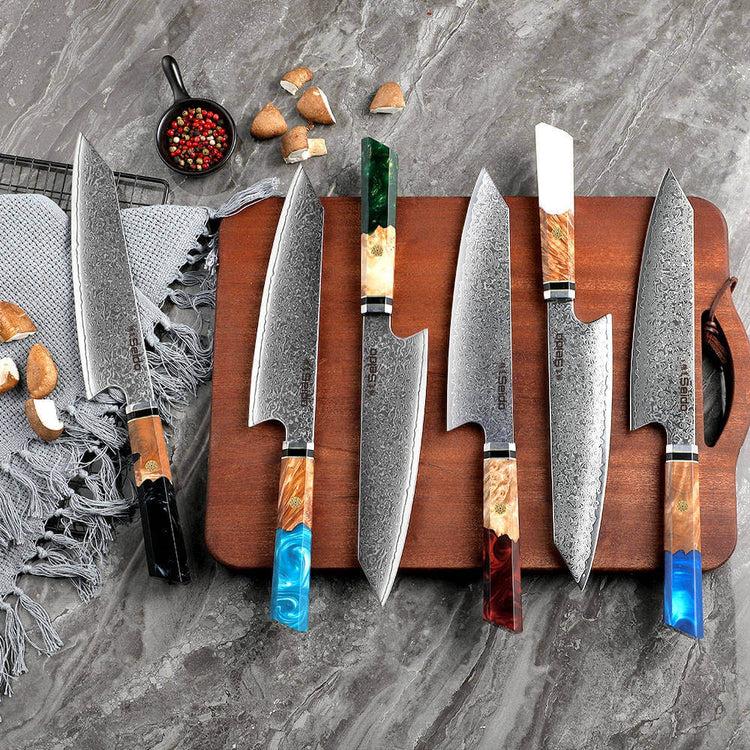Whether you’re a professional chef or someone who enjoys cooking at home, you understand how important the right set of knives is for creating exceptional culinary prep, cooking, and presentation. There’s always a lot of buzz about Japanese vs. German knives and their key differences. The best way to select a style of professional cutlery is by first getting to know the anatomy or parts of a knife before making your purchase.
Check out our helpful guide below as you decide on choosing the perfect knife for your needs. You may be surprised by the uniqueness of Japanese and German knives in the culinary industry. Both styles feature superb qualities as excellently crafted options.
It All Begins With a Professional Chef’s Knife
Ask any expert about the value of the chef’s knife, and they would tell you that this item is the most important tool in any kitchen. Many pros prefer a Japanese chef knife for its outstanding control and stability for making the sharpest cuts.
An exceptional chef’s knife is essential during the entire dish preparation process. This knife can cut, chop, slice, dice, mince, and also julienne and chiffonade. This is one versatile workhorse you don’t want to be without. Whether you choose a Japanese chef knife or a Western chef knife, your prep game will thank you.
German (Western) Knives 101
Most home cooks are familiar with German or Western knives, even though they may not pay much attention to the parts of a knife in their collection. Western knives are designed to be ambidextrous, meaning the blades feature a double-bevel or have been sharpened symmetrically on both sides. Right- or left-handed cooks can feel comfortable using a Western-style chef’s knife.
This style is also designed with a balance down the middle of the knife, making kitchen techniques easier, such as rocking chops and rapid dicing. Additionally, a German knife has a curved edge and is very sturdy, so you can easily cube a big watermelon or chop up an entire chicken. This knife is also heavier than its Japanese counterpart, meaning its gravity does most of the cutting work.
German (Western) Knife Handles
Another unique characteristic of a German chef’s knife is the handle itself. A classic German knife handle is typically made from two pieces of wood or composite material that is formed to “sandwich” the middle piece, called the tang. The handle is then secured with metal rivets.
The tang also plays a key role in any knife purchased. This is the part of the knife blade that extends into the handle. Many professional chefs prefer a full rather than partial tang as it offers greater durability, balance, and stability.
Japanese Knives 101
When looking at the anatomy or parts of a knife of the Japanese style, you will observe a slender, straight blade, typically made with a single beveled edge that is angled for right- or left-hand use. The best Japanese knife set is available in a wide variety of steel types and finishes, including stainless steel, layers of high-carbon steel, Damascus steel, or combinations of different steel types.
Many chefs at all levels fall in love with a Japanese chef’s knife for its incredible performance advantages. For one, a Japanese chef’s knife offers precision cutting, such as presenting meats and fish with paper-thin slices that enhance the food’s texture and flavor. This incredible knife style can also chop vegetables more efficiently than most other knives.
Japanese knives, like German knives, are made in different lengths. Many cooks are particular about knife size because the right knife in one’s hand can deliver better control and reduce hand fatigue while preparing food.
The best Japanese knife set contains every knife you need from prep to cooking to presentation. One advantage is the blade’s lighter weight, which allows for better maneuverability. Another plus is the blade’s more precise tip, which can easily handle detailed tasks. Japanese knife blades are also known for their extreme sharpness and can remain that way, thanks to prolonged edge retention.
Japanese Knife Handles
Like their German or Western counterparts, Japanese knife handles are essential parts of a knife that can transform your cooking. The handles are recognizable by their cylindrical shape, simplicity, and lack of a bolster, and are primarily made of wood. The handles are quite elegant aesthetically and lightweight. The best Japanese knife set is a collection of knives that does not have the thick-riveted tang seen on German knives. Despite the absence of rivets, Japanese handles are exceptionally sturdy.
Many professional chefs enjoy using the Japanese lighter knife handle because it shifts the blade’s balance closer to the hand, allowing for improved control and precision.
German, Japanese, or Perhaps a Combination of the Two Styles
There isn’t a wrong or right answer when it comes to owning professional chef’s knives. It’s a matter of preference. Most culinary experts have a set of both German and Japanese professional knives.
Often, it depends on the kind of cuisine the chef or cook is preparing as well as the desired cutting technique involved (for example, rocking vs. precise up-and-down motions).
The best knife style for you is the one that feels good in your hand and works best for your unique needs.
Are You Ready to Elevate Your Cooking Game?
Start with a professional chef’s knife of exceptional quality. It’s an investment that will elevate your food’s flavor, texture, and overall presentation. A well-chosen set of professional knives, properly cared for, can last a lifetime, whether you are a seasoned chef or a passionate home cook. It doesn’t get much better than that.
Take a moment to review the parts of a knife as outlined in the guide above and get ready to make a sharp choice!



